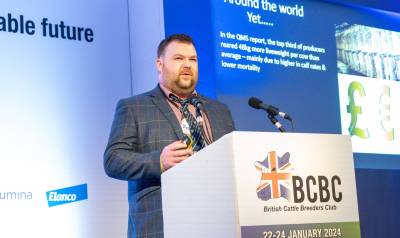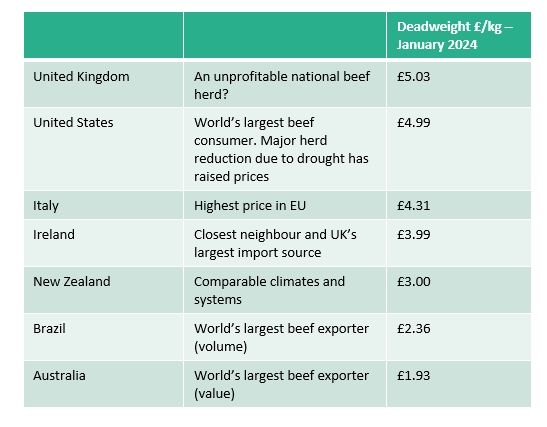
I am a fourth-generation beef farmer, with a first generation business. When I started my business in 2016, in order to obtain funding, I had to demonstrate to the bank that I could buck the trend at the time and build a business that could tackle the major issues that the industry faced such as rising input costs and market volatility.
My herd, management and breeding principles are fully focused on what a modern suckler herd needs to achieve, in terms of productivity, maintenance costs, labour units required and environmental credentials. I have been very focused on meeting the KPI targets that suckler herds need to achieve, building a farming system and developing breeding principles that help make these targets achievable. I also looked around the world to nations who, with much lower deadweight value, are able to prosper due to their lower cost of production.

My business has grown from scratch, this year we will bull 250 suckler cows and heifers on approximately 650 acres, split between owned, rented and contract farmed, with 50 of those cows leased. Due to the considerable growth the business has seen, working capital has always been in short supply, so I have had to develop a system which is “Lean & Mean”. I manage cash flow by selling store cattle, finishing bulls, heifers & steers as well as selling breeding heifers and bulls. I have observed that the UK beef industry is heavily mechanised, over staffed and under efficient. Too much money is tied up in machinery to service the needs of cattle, which leads to enormous depreciation and fixed costs. Labour use efficiency can also be improved by simplifying systems, better breeding decisions and capturing economies of scale where possible.
Due to the nature of my business, I have had to build a system that makes the most of my cheapest resource – grass. One of the key messages I have heard about building a low input system is to build the system first and the cow herd second. The farming system and breeding principles will provide a greater bang for your buck than over fixating on which colour of cow you breed. Before you design your system, you need to understand your farm and what it is capable of. For us, due to the elevation, topography, soil type and spread-out nature of the land we farm, our best option is for an upland suckler herd, outwintered, with the calves being finished on our lower ground farm. Once that has been established, we then need to look at getting the right type of animal. For us, due to the need to outwinter, calve outside with low labour requirement, thrive from forage and have a saleable carcass that is quick to finish – we use Aberdeen Angus and Stabiliser genetics.
Our cows spend their whole lives outside, from being born outside as a calf, wintering outside as a weaned calf and in-calf heifer to wintering outside as a mature cow. Our heifer calves are wintered on a similar system to their mothers partly due to the lower wintering costs, but it also applies selection pressure. The wintering setup usually comprises of deferred grass/bale grazing and rotational grazing paddocks through summer. Hardy cows breed hardy calves and hardy calves become hardy cows.
Our breeding policy revolves around carefully applying selection pressure where it is most effective. The farm and the system decide which cows thrive and which don’t, those who do not suit the system are not bred in future years rather than adding complexity trying to retain every animal. We operate a strict culling policy for any issues that add cost, for example poor foot structure, poor udders, bad mothering ability or inability to hold condition. We also maintain rigorous records on our herd, taking note of birthweight, calf vigour, calving ease, teat and udder structure, body condition, weaning and mature cow weights, frame score and we ultrasound scan pedigree bulls and heifers. All of these records inform our decisions and also provide useful information for bull customers. We also try to use EBVs sensibly and take time to interpret the information the best we can.
My view on building a profitable suckler herd
- Keep fixed costs to an absolute minimum – invest in flesh, not metal
- Streamline! Remove unnecessary processes – dehorning, foot trimming?
- Reduce labour requirement/economies of scale
- Get the basics right – control the controllables
- Utilise data to improve accuracy of decision making, invest time in data capture and interpretation
- Constant pursuit of improvement but understand the trade offs
Finishing animals born from this system are generally good forage converters and cheap to finish. We use data gathered from finishing to optimize selection, for example there is a balance to be found between cow size and being able to meet carcass specification. We aim to do most growth when it’s cheapest to do, in summer, using compensatory growth. In beef production systems, feed accounts for up to 80% of the total direct costs incurred by farmers so why not try to mitigate that cost? Compensatory growth is a naturally occurring process, where cattle have the potential following a period of under-nutrition or dietary restriction, to undergo accelerated growth and enhanced feed efficiency when subsequently offered unrestricted access to high quality feed. Why swim against the tide and push cattle hard through winter when everything costs more?
We finish steers and heifers at 18-20 months after intensive rotational grazing on high quality legume pastures with a brief housing period in autumn, if needed, where a small amount of concentrates can be used to add finish if required. We aim for a 280-330 kg R4L carcass which is the optimum for us under the current grading system.
We have also been operating a conventional bull beef system on some of our male calves, our plan is to transform the bull beef enterprise from conventional to a grass-based techno grazing system in 2024. We have observed that our 100% forage reared pedigree breeding bulls reach carcass spec by 16 months on forage alone, so we have decided to apply a similar theory to finishing bulls. There will be some trial and error, it will be dependent on hitting the compensatory growth sweet spot and maintaining very high-quality pasture during the finishing period. The outcomes would be to maintain short days to slaughter whilst reducing concentrate use and increased margin. Grass demand profile also meets grass growth spike closely. We have been modelling this system in advance using a feed budgeting program called Farmax. It gives you the ability to enter grass growth data and projected stocking rates and build a picture of how the farm operates on paper. It gives you the ability to compare different scenarios, such as adjusting weaning dates, feeding strategies or fertiliser applications and work out what the effects are on your Gross Margin per hectare.
Take Home messages
- Invest time in understanding your business instead of spending time firefighting.
- Invest in flesh, not metal. Be lean & mean!
- System first, cows second
- Apply selection pressure where it matters most
- A simple system with low fixed costs, low machinery costs, low fuel use & reduced days to slaughter can be an obtainable target for most farms on the road to reducing their carbon footprint. No need to re-invent the wheel
- Strong correlation between productivity, efficiency, emissions & profit. Well managed pasture-based systems can also improve soil health and biodiversity.
And lastly… YOU are in charge of your own destiny